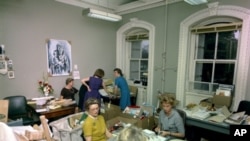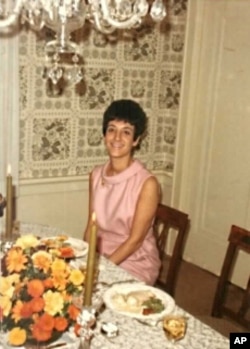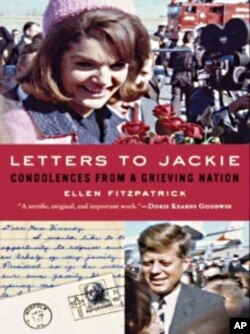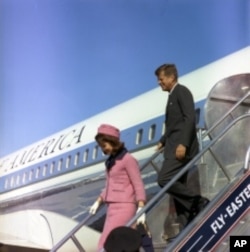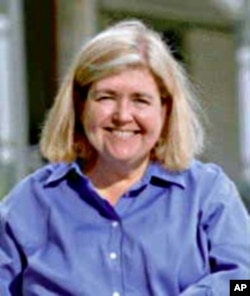After President John F. Kennedy was assassinated on November 22, 1963, his widow, Jacqueline, received an estimated one and a half million letters of condolence.
About 800,000 of them arrived within the first seven weeks after the president's death. Most of those letters were destroyed, but 15,000 of them were sent to the John F. Kennedy Library in Boston, Massachusetts, where they sat, untouched, for more than four decades.
Letters to Jackie
Now, some are available for the public to read, in a new book called, "Letters to Jackie: Condolences from a Grieving Nation."
One of those letter writers was Gabriele Gidion, who has lived and worked in New York City since she emigrated from Germany with her parents after World War II. She vividly remembers where she was and how she felt when she heard the news about President Kennedy.
"I was in the garment center, 1400 Broadway [in New York]," she recalls. "We were reviewing a line and somebody came in running and said, 'The president was assassinated.' We were in total disbelief. I get goosebumps just talking about it again. There are certain periods in my life that are defining moments. It was one of the defining moments of my life."
Gidion was 26 years old when she wrote a condolence letter to Jackie Kennedy. The letter reads, in part:
"Twenty-six years of escaping from Hitler, growing up in wartime China fleeing from Communism, watching my father's futile struggle against cancer, seeing my roommate killed in an automobile accident… all these I deemed adequate preparation for some of life's bitter moments. Yet never, until last Friday, have I felt such desperate sense of loss and loneliness."
Reflection of society, politics
Gidion's letter is one of about 250 that Ellen Fitzpatrick chose to include in her book, "Letters to Jackie."
When the New Hampshire history professor visited the Kennedy Library more than a year ago, she was working on a different project: how Americans perceived John Kennedy when he was president. When she started to read the condolences letters, she says, she was astonished by what she found.
"What I began to read were letters from small towns, big cities, from every part of the country, from very, very diverse Americans," Fitzpatrick says. "There were letters from dairy farmers. There were letters from children. There were letters from Republicans. There were letters from Native Americans on reservations. There were many, many letters from African Americans. Some of them were just scrolled on a little scrap of papers in pencils. Some of them were written on elegant stationary."
That was when Fitzpatrick decided to change her research topic and focus on the letters.
"It came clear to me right away, when I was working on the letters that they fill roughly into 3 categories," she says. "There were letters that talked about November 22, that day, how people responded. There were many letters reflected on politics, on society, on their views of the presidency. And finally, there were letters, in which people in their effort to console Mrs. Kennedy reflected upon their own experiences with grief and loss. Those became the three parts of the book."
The common thread among the letters, Fitzpatrick says, is sincerity and directness, such as this one, written by 14-year-old Tommy Smith. He had seen the Kennedys in Dallas just before the assassination.
"Dear Mrs. Kennedy:
I know the grief you bear. I bear that same grief. I am a Dallasite. I saw you yesterday. I hope to see you again. I saw Mr. Kennedy yesterday. I'll never see him again. I'm very disturbed because I saw him a mere 2 minutes before that fatal shot was fired. I couldn't believe it when I heard over the radio 5 minutes later. I felt like I was in a daze. To Dallas, time has halted. Everyone is shocked and disturbed. My prayers to you, a sympathetic, prayerful, and disturbed Dallasite, Tommy Smith"
The youngest letter writer in the book is Tony Davis. He was seven when he wrote his condolence note.
"It was a simple piece of paper in which he just simply said, 'I'm sorry he is dead,'" Fitzpatrick says. "and his mother wrote on the bottom of the letter that, 'PS: Tony wrote this the evening after hearing of the President's death and it so aptly yet simply expresses the feelings of all of this family that I have decided to send it on to you.'"
Age of innocence
Historian Ellen Fitzpatrick says Kennedy's assassination had such an emotional impact because Americans felt they knew him, personally.
"President Kennedy was really the first television President," she explains. "He and Mrs. Kennedy were raising the youngest children in the White House of any presidential couple in the 20th century and they were doing that at a time when the World War II generation was raising the baby boomers. So a lot of Americans identified with this young couple in the White House. They felt, through TV, they had come to know this family very well."
And, she adds, it was a less politically cynical age, as well.
"This is a period before Vietnam, which greatly increased cynicism and skepticism of many Americans about the president and how truthful he was," Fitzpatrick says. "And it's before Watergate, which badly damaged the faith of many Americans in the presidency for some time after that. I don't want to romanticize the early 1960s because there were very difficult problems the country was struggling with at that moment and we've made enormous progress since then, but yes, there was a kind of faith, belief and affection for the president that I think had been a casualty of the modern era, when we know much more about these men than we did when President Kennedy was president."
Ellen Fitzpatrick says future historians are unlikely to have collections like these condolence letters for their research. With cell phones and e-mail, people just don't send hand-written letters as much as they used to. But she is happy that she had such a resource to let future generations know how much President Kennedy meant to the American people.




